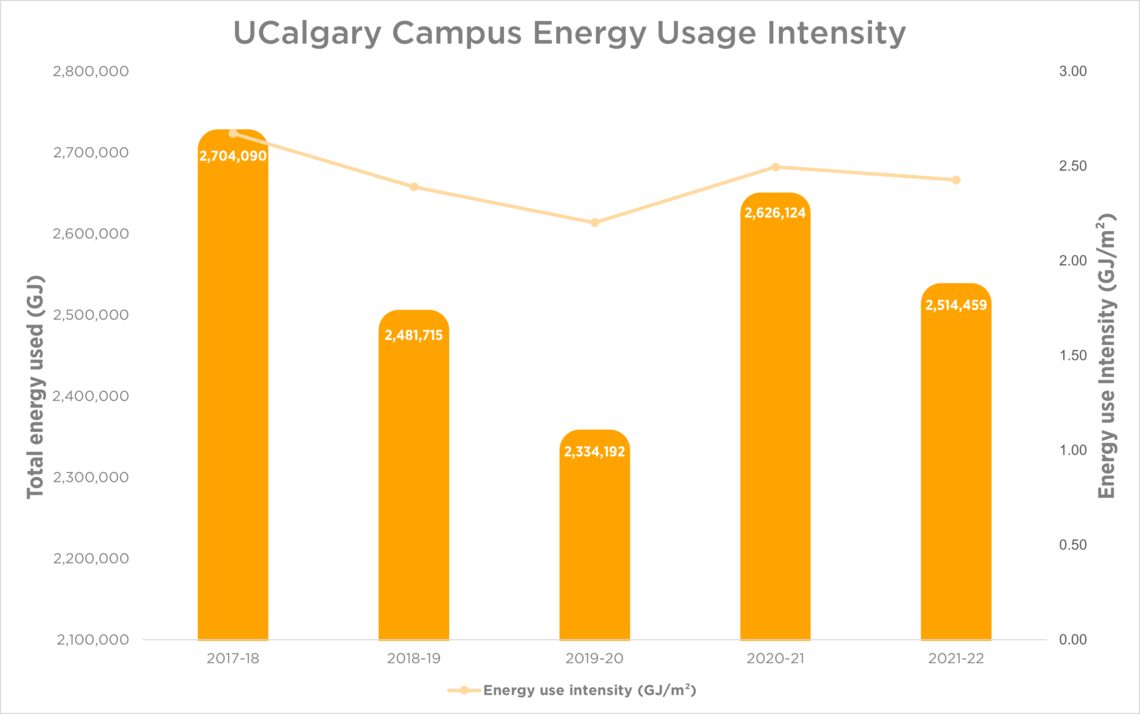
Climate and Energy
UCalgary saves annual utility costs by reducing GHG emissions from our built environment.
Help reduce a building's electricity usage by up to a third:
Energy Leadership
UCalgary is a Canadian post-secondary leader in carbon emissions reductions.
As a signatory to the 2015 Paris Agreement, Canada committed to reducing greenhouse gases (GHG) by 30 per cent across the country by 2030 in an effort to help reduce global carbon emissions. The University of Calgary surpassed the 2030 target more than a decade ahead of time, attaining a GHG reduction of over 30 per cent across the institution since 2008.
Guided by the University of Calgary’s Climate Action Plan and the Institutional Sustainability Strategy (ISS) and its framework on Sustainability in Administration and Operations, UCalgary is striving to attain net-carbon neutrality by 2050 through being a Canadian post-secondary leader in energy efficiency and healthy, high performance green buildings.
Cogeneration System: Combined Heat and Power
UCalgary’s Central Heating and Cooling Plant’s Cogeneration system has reduced institutional GHG emissions by more than 60,000 metric tonnes each year since 2011.
Renewable Energy
UCalgary is shifting towards a cleaner and greener energy supply by generating our own renewable energy with on-site photovoltaic (PV) arrays.
Energy Efficiency
Existing Buildings: Utility Reduction Program
Since 2015, the Utility Reduction Program (URPr) has invested more than $35 million in renewed and optimized building systems at the Main and Foothills campuses. This includes the support of 14 million in external funding including 8.6 M from the Low Carbon Economy Fund. The impact of this investment has reduced UCalgary’s greenhouse gas (GHG) emissions by ~33,000 tonnes CO2equivilent per year and $8 million in calculated utility cost avoidance annually (based on the 2023 rates).
Projects within the program are designed to bring aging infrastructure up to more energy efficient standards with a focus on mechanical upgrades, lighting retrofits, and installation of energy recovery systems. URPr selects and implements projects based on its potential to improve building energy efficiency and reduce GHG emissions.
The URPr investments into the building controls enable improved indoor environmental air quality by tracking ventilation rates within the laboratory spaces to ensure they are meeting the operation requirements of the space. In addition, demand control ventilation improves indoor air quality by allowing the ventilation system to adjust for increased times of building and space occupancy.

Energy Demand Management Plan
In 2020, UCalgary engaged in developing an Energy Demand Management Plan (EDMP). The EDMP is a strategic document dedicated to improving existing building energy performance. A supporting document to the 2019 CAP, the EDMP’s identifies engagement, operational, reporting and technological advancement opportunities that will enable the institution to reach its 50% GHG emission reduction target by 2030. The EDMP prioritizes efforts on energy intensive buildings by identifying, screening and implementing energy improvement projects across the institution’s top energy users. Proposed initiatives include the Utility Reduction Program (URPr), deep energy retrofits, and energy optimization and operational improvements.
These programs will use data-driven decision making processes to improve institutional energy performance, reduce GHG missions and avoid utility costs, thereby creating more sustainable and energy-efficient campuses. Inspired by best practices in energy management, including the internationally recognized ISO 50001 standard, the EDMP offers impactful recommendations to unite people, technology and processes and align them with the university’s strategic vision for sustainability.
Energy usage
UCalgary continues to take meaningful actions towards reducing its overall energy consumption. In conjunction to the EDMP, the university is working hard to ensure sufficient resources are available for the campus community to develop an understanding of ways they can reduce energy consumption.

GHG Emissions Reductions
UCalgary has reduced GHG emissions* by implementing initiatives and programs that make our energy supply and buildings more efficient. As of 2022, we have achieved a 39 per cent reduction from our 2008 baseline, eliminating more than 92,000 tonnes in annual GHG emissions. That’s equivalent to taking approximately 30,000 passenger vehicles off the road for a year.
*Scope 1 and Scope 2 emissions, taking into account energy efficiency conservation measures in 2022-23.


New Buildings: Green Building Program
With 14 Leadership in Energy and Environmental Design (LEED) certified projects, and 4 registered projects currently underway, UCalgary is a Canadian leader in high performance green buildings. Find out how the redeveloped MacKimmie Tower is a high-performance, net-zero carbon building and one of the first projects striving for certification with the Canada Green Building Council’s Zero Carbon Building Standard.




